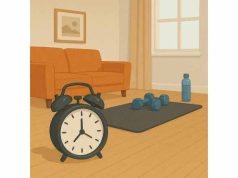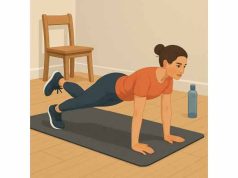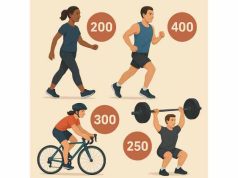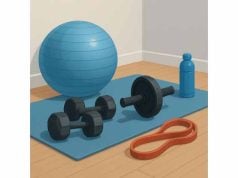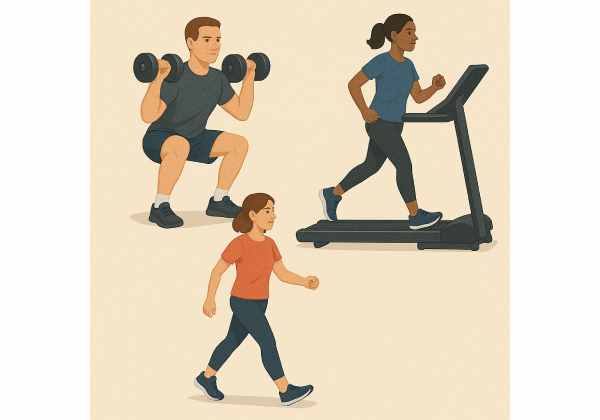
Exercise helps you lose weight in three ways: it raises daily energy use, preserves (or builds) muscle so your metabolism stays higher, and improves the habits that make nutrition consistent. Not every minute of exercise works the same, though. The most effective approach blends strength training, purposeful cardio, and lots of everyday movement. This guide explains how each piece contributes, how to structure your week, and how to progress without burning out. If you prefer a quick overview before you dive in, scan our primer on exercise options for weight loss to see how strength, cardio, and steps fit together.
Table of Contents
- What actually drives weight loss
- Strength training essentials
- Cardio: HIIT vs steady pace
- Steps and NEAT explained
- Time-based workout templates
- Weekly programming and recovery
- Who should adjust or avoid
- Frequently Asked Questions
What actually drives weight loss
Weight loss occurs when weekly energy intake is lower than weekly energy expenditure. Exercise influences both sides: it burns calories directly and indirectly, and it makes it easier to eat well by stabilizing mood, appetite, and sleep. The best plan respects that physiology while fitting your schedule and preferences.
Three levers that matter most
- Strength training protects muscle while you’re in a calorie deficit. Muscle is metabolically active tissue; keeping it reduces the drop in resting energy expenditure that can occur during dieting.
- Cardio adds sustainable calorie burn and improves aerobic capacity, which lowers the effort of daily life and helps you stay active.
- Steps/NEAT (non-exercise activity thermogenesis) are the quiet powerhouse—everything from walking to chores. This often accounts for more daily burn than formal workouts and is easier to scale without joint stress.
How to combine them
- Use strength two to four times per week to anchor your plan. Choose large compound movements (squat, hinge, push, pull, carry).
- Add cardio two to four times per week. Mix easy “conversational” work with brief intervals as your fitness grows.
- Keep steps high every day—aim for ranges you can maintain during busy weeks.
Setting expectations
- A realistic, sustainable loss for many adults is 0.25–0.75 kg (0.5–1.5 lb) per week on average. Expect normal day-to-day fluctuations from water and glycogen.
- Track weekly averages for scale weight and steps. Use the mirror, clothing fit, and simple circumference measures every two to four weeks.
- Pair training with protein-forward meals, colorful plants, and mostly minimally processed foods. Sleep and stress management matter as much as an extra cardio session.
Common myths, quickly corrected
- “Fat-burning zones” guarantee fat loss. The body uses mixed fuels at all intensities; total weekly energy balance and consistency matter more.
- “HIIT is the only efficient cardio.” HIIT is useful, not mandatory. Easy aerobic work builds capacity and pairs well with strength.
- “More soreness = more progress.” Soreness is not a goal; performance and adherence are better markers.
If you’re unsure where to begin, start with two full-body strength sessions and two cardio slots, plus daily walking. For broader context on safe pacing and expectations, see our concise hub on healthy weight-loss basics.
Strength training essentials
Strength is the backbone of a smart fat-loss plan. When calories dip, the body happily sheds any tissue it deems nonessential—unless you give it a reason to keep muscle. Strength work provides that reason, maintaining lean mass, joint integrity, and training economy.
Principles that drive results
- Big patterns first. Build sessions around squat, hinge, push, pull, and carry. These recruit large muscle groups and deliver the most return for time.
- Effort, not exhaustion. Work sets should feel challenging while keeping 1–2 reps in reserve (RIR). Technique and control beat grinding to failure.
- Progressive overload. Add a little load, a rep, one set, or slow the tempo once the current plan feels controlled. Change one variable at a time.
- Frequency and volume. Most people progress on 2–4 sessions per week, with 8–16 hard sets per big pattern across the week. Beginners thrive at the low end.
A 45–60 minute template (scale to 30 minutes if needed)
- Warm-up (5–8 min): easy cardio, hip hinges, ankle rocks, arm circles; two 20–30-second primers.
- A block (lower + upper):
- Goblet squat or leg press — 3 sets × 6–10 reps
- One-arm row (DB/cable) — 3 × 8–12 per side
- B block (hinge + push):
- Romanian deadlift or hip thrust — 3 × 6–10
- Push-up or DB bench press — 3 × 8–12
- C accessory (core or carry):
- Suitcase carry 20–30 m × 3–4 trips, or dead bug/side plank
Short on time? Turn sets into strength intervals: 40 seconds work / 20 seconds rest, alternating two moves for eight rounds. You’ll keep quality up while modestly raising heart rate.
Equipment swaps
- No barbell? Use kettlebells or dumbbells for goblet squats, RDLs, and carries.
- No weights? Slow tempo (3-1-0) and pauses increase challenge on bodyweight squats, split squats, and push-ups.
Joint-friendly adjustments
- Knees cranky: prioritize hinges, step-ups, and leg press; squat to a target.
- Low back sensitive: choose chest-supported rows, goblet squats, and hip thrusts; keep RDLs lighter with controlled range.
- Shoulders sore: floor press instead of deep bench, neutral-grip rows and presses.
What about calories?
Strength sessions don’t always “burn” as many calories as hard cardio in the moment, but they protect the muscle that keeps your 24-hour burn higher. They also improve insulin sensitivity and activity tolerance so you move more between workouts.
If you want a simple starter plan that fits busy weeks, our concise 3-day beginner strength plan shows loads, reps, and progressions you can follow for eight weeks.
Cardio: HIIT vs steady pace
Cardio complements strength by increasing weekly energy expenditure and aerobic capacity. You don’t have to choose sides: both steady-state (easy to moderate pace) and HIIT (hard intervals) work—use each for its strengths.
Steady-state (often called Zone 2)
- Feel: conversational breathing; you can speak in full sentences.
- Benefits: builds the aerobic base that makes daily life and harder training easier; low joint stress; great for recovery days.
- How much: start with 20–40 minutes per session, two or three times a week, on a bike, rower, brisk walk (incline if needed), or swimming.
HIIT (high-intensity intervals)
- Feel: hard but repeatable efforts (speech breaks into short phrases), followed by easy recovery.
- Benefits: time-efficient dose of higher-intensity work; improves VO₂max and helps you accumulate demanding minutes without long sessions.
- How much: 10–20 minutes of intervals inside a 20–30 minute session, once or twice a week at first.
Easy ways to structure both
- Steady template: 5-minute ramp-up → 20–30 minutes steady pace → 3-minute cooldown.
- HIIT 1:1: 45s hard / 45s easy × 8–10 after a 5-minute warm-up.
- Short-burst HIIT: 20s very hard / 40s easy × 10–12 (great on bike/rower).
Which burns more fat?
Across a week, both can support fat loss if total activity is high and nutrition matches your goal. HIIT often “feels” more productive because it’s intense, but easy cardio lets you recover and move more overall. The blend you’ll repeat is best.
Picking modalities
- Low-impact: cycling, rowing, elliptical, sled pushes.
- Mixed impact: incline treadmill walking, step-ups.
- Higher impact: running and jump rope—use only if joints tolerate impact and progress gradually.
Curious when to emphasize one over the other? Our quick comparison of HIIT vs steady cardio covers how they differ and how to rotate them through the week.
Safety checkpoints
- Keep hard efforts repeatable. If your second half falls apart, lower the target or extend rest.
- Stop if chest pain, dizziness, or unusual shortness of breath appears; seek care if symptoms persist.
Steps and NEAT explained
NEAT—non-exercise activity thermogenesis—is the energy you spend outside formal workouts: walking, standing, fidgeting, chores, playing with kids, carrying groceries. For many people, NEAT varies more day-to-day than workouts and quietly determines whether a diet feels easy or impossible.
Why steps matter so much
- Easy to scale without soreness or recovery debt.
- Counters the subconscious drop in movement that often occurs in a calorie deficit.
- Supports blood sugar control and appetite regulation, especially with short walks after meals.
Targets that actually work
- Choose a floor/target/ceiling you can hit most days—for example 7k / 10k / 13k steps. Weekly averages matter more than single days.
- If you’re sedentary, add 500–1,000 steps every few days until you reach a sustainable range.
- Use indoor options during heat, cold, or storms: treadmill, mall laps, stairs.
Practical ways to raise NEAT
- Short 5–15-minute walks after meals.
- “Walk the call” policy for phone meetings.
- Park at the far edge; take stairs for one or two flights.
- Set a gentle hourly movement reminder; do two minutes of easy movement when it pings.
For a deeper list of friction-free ideas that fit office life, see our guide to burning more calories without “working out”. If you prefer a single number to chase, some people enjoy the clarity of 10,000 daily steps, but think in weekly totals so life can happen without guilt.
Footwear and surfaces
- Rotate comfortable, supportive shoes; vary surfaces (asphalt, track, treadmill) to spread stress.
- If shins or feet ache, shorten stride, slow the pace, and build back gradually.
Time-based workout templates
Busy weeks call for clear formats. Use these plug-and-play templates based on how much time you have. Each template balances strength, cardio, and movement quality.
15 minutes (minimum viable workout)
- Warm-up (2 min): brisk walk or cycle; hip hinges and arm circles.
- Strength circuit (10 min): 30s work / 15s rest, rotate
- Squat (goblet or bodyweight)
- Push-up (incline as needed)
- Hip hinge (RDL or good-mornings)
- Row (DB/band)
- Cooldown (3 min): easy walk and breathing.
20 minutes (interval emphasis)
- Warm-up (3 min) → Intervals (14 min): 40s hard / 20s easy × 7 on bike/rower or incline walk → Cooldown (3 min).
- Option: replace machine intervals with step-overs + shadow boxing 30/30 × 7. For ready-made sessions, see our quick 20-minute HIIT options.
30 minutes (balanced strength + cardio)
- Warm-up (5 min).
- Strength intervals (16 min): 40s work / 20s rest × 8 (alternate squat with push; hinge with row).
- Finisher (6–7 min): 30/30 repeats on bike/rower or 20s swings + 40s easy walk × 6.
- Our full set of short, effective templates lives here: 30-minute fat-burning workouts.
45 minutes (strength priority)
- Warm-up (6–8 min).
- A Block: squat + row, 3×6–10 each (superset).
- B Block: hinge + press, 3×6–10 each.
- C Accessory: carry or core, 2–3 sets.
- Short finisher (4–5 min): 30/30 repeats × 5.
Scaling rules
- Keep technique crisp; if speed breaks form, slow down or reduce load.
- Progress one variable at a time: +1–2 total intervals, +2–5% load, or −5–10 seconds rest.
- When life explodes, do the 15-minute minimum viable workout to protect momentum.
Weekly programming and recovery
Think of your week like a budget: enough stress to progress, enough recovery to repeat. Most busy adults thrive on 3–5 training days, a mix of intensities, and lots of steps.
Three sample weeks
Beginner (3 days)
- Mon: Full-body strength (30–45 min)
- Wed: Steady cardio (Zone 2, 25–40 min)
- Fri: Full-body strength (30–45 min)
- Daily: Steps in a realistic range (e.g., 7–10k)
Intermediate (4 days)
- Mon: Strength (lower emphasis)
- Tue: HIIT (20–25 min) or intervals after a short warm-up
- Thu: Strength (upper emphasis)
- Sat: Steady cardio (30–45 min) or long walk with hills
Time-crunched (5 × 30 min)
- Alternate strength-interval days and cardio-finisher days. Keep at least one lighter day if stress is high.
Progress markers
- Strength: complete all planned sets at a given load with clean reps → add a small increment next time.
- Cardio: hold slightly faster pace/watts at the same effort, or repeat more intervals at an even quality.
- Recovery: sleep quality stable, appetite normal, mood steady.
Recovery anchors
- Sleep 7–9 hours when possible; short sleep increases hunger and lowers non-exercise movement.
- Protein 20–40 g per meal, fiber from plants, and adequate hydration (a pinch of salt helps in hot climates).
- Deload every 4–6 weeks: reduce strength sets and interval count by ~30–40% for one week.
For help spacing challenging and easy days—especially if work and family schedules are unpredictable—use our brief guide on how many rest days per week to balance stress and recovery without losing progress.
Who should adjust or avoid
Most healthy adults can train safely with the frameworks above, but context matters. Adjust impact, intensity, and volume to your needs.
New or returning exercisers
- Start with two or three training days.
- Keep strength work at RPE 6–7/10 and leave 1–2 reps in reserve.
- Choose low-impact cardio (bike, rower, incline walk) and equal work\:rest intervals.
Higher body mass or joint pain
- Favor machine-based cardio, sled pushes, and step-ups to a comfortable height.
- Shorten work bouts (20–30 seconds) and lengthen recovery (40–60 seconds).
- Use softer surfaces, rotate supportive footwear, and progress hills/incline gradually.
Older adults
- Emphasize balance and tempo control (sit-to-stands, heel-to-toe walks, chest-supported rows).
- Machines can reduce joint irritation while keeping intensity meaningful.
- Aim for consistency, not maximal loads.
Pregnancy and postpartum
- Many can continue training with the talk test and smart cooling; avoid overheating and high-impact drills as advised.
- Postpartum, rebuild with breath and pelvic-floor coordination before heavier loading.
Medical conditions and medications
- If you live with cardiovascular, metabolic, or orthopedic conditions—or take medications that affect heart rate or balance—get personalized parameters. Use effort cues (RPE, ability to speak in short phrases) more than formulas when meds alter heart-rate response.
Stop-signs
- Chest pain, unusual shortness of breath, dizziness, or sharp joint pain. Stop the session and seek care if symptoms persist.
Green-light signs
- Technique stays crisp; breathing recovers within a minute or two; you feel pleasantly worked, not flattened, within an hour of finishing.
Frequently Asked Questions
What’s the single best exercise for weight loss?
There isn’t one. Combine full-body strength training (to keep muscle) with cardio you’ll repeat and high daily steps. The best exercise is the one you perform consistently with good form, in a program that fits your schedule and supports a modest calorie deficit.
Is strength or cardio better for fat loss?
Both matter. Strength training preserves muscle and keeps your resting burn higher; cardio adds sustainable weekly energy expenditure and fitness. You’ll get the best results by doing both, plus lots of everyday movement, with nutrition aligned to your target.
How many workouts per week do I need?
Most people do well with 3–5 days: two to three strength sessions and one to three cardio slots, plus daily steps. Beginners can start with two strength days and one cardio day, then add volume as recovery and schedule allow over several weeks.
Can I lose weight with walking alone?
Yes—especially if you’re sedentary now—but progress is steadier when you pair walking with simple strength work and protein-forward meals. Aim for a weekly step average that’s realistic, then layer in two short strength sessions to protect muscle and joint health.
Do I need HIIT to lose fat?
No. HIIT is time-efficient but optional. Many people prefer steady aerobic work (conversational pace) and see excellent results. If you enjoy intervals, cap them at two days per week at first and keep efforts hard but repeatable to protect recovery.
How long before I see results?
Many notice improved energy and fitness within two weeks. Visible changes in body composition often appear within 3–6 weeks when training, steps, sleep, and nutrition line up. Track weekly averages for weight and steps, and use clothing fit and simple measurements every few weeks.
Will ab exercises burn belly fat?
No specific exercise targets fat in one area. Ab training strengthens your core and supports posture and lifts, but overall fat loss comes from a sustained calorie deficit with smart training and steady daily movement.
References
- Effect of High-Intensity Interval Training vs. Moderate-Intensity Continuous Training on Fat Loss and Cardiorespiratory Fitness in the Young and Middle-Aged a Systematic Review and Meta-Analysis 2023 (Systematic Review & Meta-analysis)
- Aerobic Exercise and Weight Loss in Adults: A Systematic Review and Dose-Response Meta-Analysis 2024 (Systematic Review & Dose–Response Meta-analysis)
- Comparing exercise modalities during caloric restriction: a systematic review and network meta-analysis on body composition 2025 (Systematic Review & Network Meta-analysis)
- After Dinner Rest a While, After Supper Walk a Mile? A Systematic Review with Meta-analysis on the Acute Postprandial Glycemic Response to Exercise Before and After Meal Ingestion in Healthy Subjects and Patients with Impaired Glucose Tolerance 2023 (Systematic Review & Meta-analysis)
- Objectively determined physical activity and adiposity measures in adult women: A systematic review and meta-analysis 2022 (Systematic Review & Meta-analysis)
Medical Disclaimer
This article provides general information and is not a substitute for personalized medical advice. Always consult your healthcare professional before starting or changing an exercise or weight-loss program, especially if you have medical conditions, are pregnant or postpartum, or take medications that affect heart rate, blood pressure, or balance.
If this guide helped you, please consider sharing it with a friend. You’re welcome to follow us on Facebook or X for practical templates and steady, evidence-based tips.



